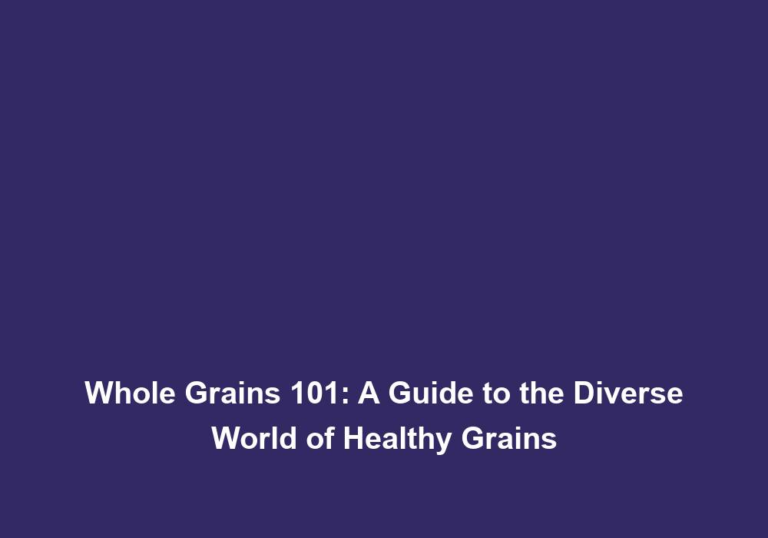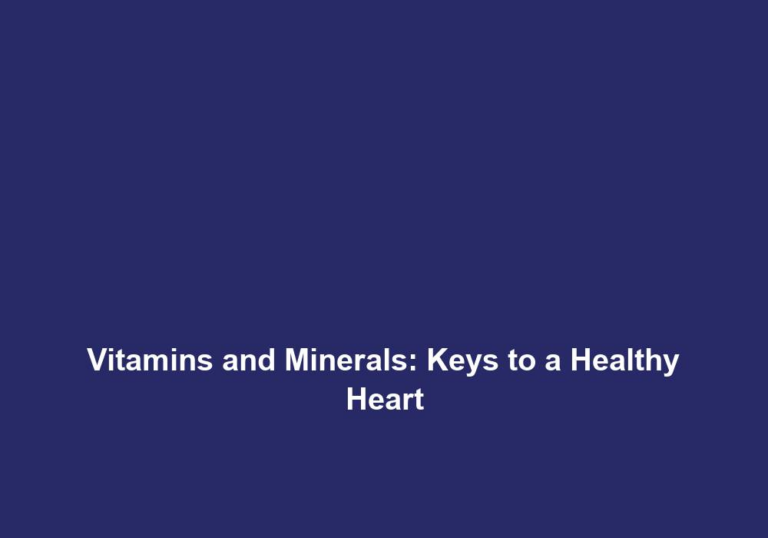Whole Grains Decoded: Choosing the Right Varieties for Your Diet
Whole grains play a crucial role in maintaining a healthy diet, offering a wide range of nutrients and numerous health benefits. However, with the vast array of varieties available, it can be overwhelming to determine which ones to incorporate into your meals. In this article, we will delve into the world of whole grains, providing you with valuable insights to help you make informed choices that will benefit your overall well-being.
What are Whole Grains?
Whole grains encompass grains that consist of all three parts: the bran, germ, and endosperm. This means they retain all the essential nutrients and fiber present in the original grain. On the other hand, refined grains have undergone a process that removes the bran and germ, leaving behind only the starchy endosperm.
Including whole grains in your diet can significantly reduce the risk of chronic diseases such as heart disease, type 2 diabetes, and certain types of cancer. Moreover, they provide essential nutrients like vitamins, minerals, and antioxidants. Now, let’s explore some popular varieties of whole grains to help you decide which ones to incorporate into your meals.
1. Brown Rice
Brown rice, a whole grain that maintains its bran and germ, offers superior nutrition compared to white rice. It serves as an excellent source of manganese, selenium, and magnesium. With its nutty flavor and slightly chewy texture, brown rice proves to be a versatile option for various dishes, including stir-fries, pilafs, and salads.
When it comes to the health benefits of brown rice, its high fiber content aids in digestion and helps regulate blood sugar levels. Additionally, it contains a range of B vitamins, which are essential for energy production and overall well-being.
To fully embrace the versatility and nutritional value of brown rice, consider incorporating it into stuffed bell peppers or using it as a base for grain bowls loaded with colorful vegetables and lean protein.
2. Quinoa
Quinoa, often hailed as a complete protein, contains all nine essential amino acids. It is also gluten-free and rich in fiber, iron, and magnesium. With its delicate texture and slightly nutty taste, quinoa has gained popularity as a versatile choice for salads, side dishes, and even as a substitute for rice or couscous.
The high fiber content in quinoa aids in digestion and promotes feelings of fullness, making it an excellent choice for those looking to manage their weight. Additionally, quinoa is packed with antioxidants, which help protect the body against harmful free radicals and oxidative stress.
To fully enjoy the benefits of quinoa, try incorporating it into your favorite salad recipes, mixing it with roasted vegetables for a nourishing side dish, or using it as a filling for stuffed peppers or mushrooms.
3. Oats
Oats, a highly nutritious whole grain, are commonly consumed as oatmeal or incorporated into baked goods. They are an excellent source of soluble fiber, which plays a vital role in reducing cholesterol levels and improving heart health. Oats are also abundant in vitamins, minerals, and antioxidants, making them a valuable addition to your diet.
The soluble fiber in oats forms a gel-like substance in the digestive system, which helps slow down digestion and keeps you feeling satisfied for longer periods. This can aid in weight management and prevent overeating.
To incorporate oats into your daily routine, enjoy a warm bowl of oatmeal for breakfast topped with fresh fruits and nuts. You can also use oats in baking recipes, such as cookies, muffins, or homemade granola bars, to add a nutritious boost to your treats.
4. Whole Wheat
Whole wheat, a staple grain and a popular choice for bread, pasta, and baked goods, is rich in fiber, vitamins, and minerals. Whole wheat products provide more nutrients and a higher fiber content compared to their refined counterparts. Choosing whole wheat varieties when it comes to bread and pasta allows you to maximize the benefits of this whole grain.
Fiber, a key component in whole wheat, aids in digestion and promotes bowel regularity. It also contributes to feelings of fullness, making it easier to manage weight. Additionally, whole wheat is a great source of B vitamins, which are essential for energy production and overall well-being.
To make the most of whole wheat, opt for whole wheat bread for your sandwiches and whole wheat pasta for your favorite pasta dishes. You can also experiment with whole wheat flour in your baking endeavors, such as making whole wheat pancakes or muffins.
5. Barley
Barley, a versatile and nutritious whole grain, can be utilized in soups, stews, salads, or as a rice substitute. It boasts high levels of fiber, vitamins, and minerals, including manganese and selenium. With its chewy texture and slightly nutty flavor, barley adds depth and richness to various dishes.
The significant fiber content in barley aids in digestion and promotes a healthy gut. It also helps regulate blood sugar levels, making it an excellent choice for individuals with diabetes or those looking to manage their blood sugar levels.
To incorporate barley into your diet, try adding it to vegetable soups or stews for a hearty and nutritious meal. You can also use cooked barley as a base for grain bowls or salads, mixed with an array of colorful vegetables and your choice of lean protein.
6. Buckwheat
Despite its name, buckwheat is not related to wheat and is naturally gluten-free. It serves as a good source of protein, fiber, and essential nutrients like magnesium and phosphorus. Buckwheat boasts a distinct nutty flavor and is commonly used in pancakes, noodles, and porridge.
The fiber content in buckwheat aids in digestion and helps maintain healthy cholesterol levels. Additionally, it contains antioxidants that contribute to overall well-being and protect against cellular damage caused by free radicals.
To explore the versatility of buckwheat, consider incorporating it into your breakfast routine by making delicious and nutritious buckwheat pancakes. You can also use buckwheat flour to create gluten-free baked goods or enjoy it as a side dish in the form of buckwheat noodles.
7. Millet
Millet is a widely consumed grain in various parts of the world and boasts high nutritional value. It is gluten-free and contains significant amounts of protein, fiber, and antioxidants. Millet has a mild flavor and a light, fluffy texture, making it a versatile choice for a range of dishes.
The fiber in millet aids in digestion and supports a healthy gut. It can also help regulate blood sugar levels, making it an excellent choice for individuals with diabetes or those looking to manage their blood sugar.
To enjoy the benefits of millet, use it as a base for flavorful pilafs mixed with an array of vegetables and herbs. You can also add cooked millet to soups or incorporate it into your baking recipes for added texture and nutrition.
8. Rye
Rye, a versatile whole grain with a robust flavor and dense texture, is an excellent source of fiber, magnesium, and phosphorus. Rye bread is a popular choice, but you can also use rye flour in baking or add cooked rye grains to salads and side dishes.
The high fiber content in rye aids in digestion and promotes feelings of fullness, making it beneficial for weight management. Additionally, rye contains a range of antioxidants and phytochemicals that contribute to overall health and well-being.
To enjoy the unique flavor and nutritional benefits of rye, opt for rye bread instead of white bread for your sandwiches. You can also experiment with rye flour in your homemade bread or use cooked rye grains as a nutritious addition to salads and side dishes.
Conclusion
Incorporating a variety of whole grains into your diet is a simple and effective way to enhance your overall health. By experimenting with different whole grain options, you can find the ones that suit your taste preferences and dietary needs. Whether it is brown rice, quinoa, oats, or any other whole grain, choosing the right varieties allows you to reap the numerous benefits they offer. Start making wholesome choices today and nourish your body with the power of whole grains.







